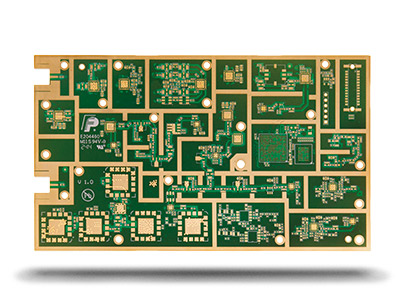The definition of a transmission line is a signal line with a signal return (consisting of two wires of a certain length, one is the signal propagation path, and the other is the signal return path). The common transmission line is also the trace on our PCB board. So, how long is the trace on the PCB board is the transmission line?

How long is the trace on the PCB board to be a transmission line?
This is related to the propagation speed of the signal, which is 6in/ns in the copper lines on the FR4 board. Simply put, as long as the round-trip time of the signal on the trace is greater than the rise time of the signal, the trace on the PCB should be handled as a transmission line. Let's see what happens when a signal travels over a long trace. Suppose there is a 60-inch PCB trace, the return path is the ground plane on the inner layer of the PCB close to the signal line, and the signal line and the ground plane are open at the far end. The signal propagates forward on this trace, it takes 10ns to transmit to the end of the trace, and another 10ns to return to the source, so the total round-trip time is 20ns. If the signal round-trip path above is regarded as an ordinary current loop, there should be no current on the return path because it is open at the far end. But this is not the case, the return path has been current for some time after the signal is on.
Add a signal with a rise time of 1ns to this line. In the first 1ns time, the signal only traveled 6 inches on the line. I don’t know whether the far end is open or short, so how much impedance does the signal feel? Sure? If the signal round-trip path is regarded as an ordinary current loop, there will be contradictions, so it must be treated as a transmission line. In fact, there is the parasitic capacitance between the signal traces and the return ground plane. When the signal propagates forward, the voltage at point A does not change continuously. For parasitic capacitance, the changing voltage means current is generated. Therefore, the impedance felt by the signal is the impedance presented by the capacitor, and the parasitic capacitance constitutes the path for the current to flow back. At each point the signal travels forward, it experiences an impedance resulting from the application of a changing voltage to the parasitic capacitance, commonly referred to as the transient impedance of the transmission line.
When the signal reaches the far end, the voltage at the far end rises to the final voltage of the signal, and the voltage does not change. Although the parasitic capacitance still exists, there is no voltage change, the capacitance is equivalent to an open circuit, which corresponds to the DC situation. Therefore, the short-term behavior of this signal path is not the same as the long-term behavior, and in the initial short period, the behavior is the transmission line. Even with an open circuit at the far end of the transmission line, during signal transitions, the front end of the transmission line will behave like a finite-value resistor. Let’s clarify a few concepts first. We often see impedance, characteristic impedance, and instantaneous impedance. Strictly speaking, they are different, but they are still the same. They are still the basic definition of impedance: the input at the beginning of the transmission line. Impedance is referred to as impedance for short; the instantaneous impedance that the signal encounters at any time is called instantaneous impedance; if the transmission line has a constant instantaneous impedance, it is called the characteristic impedance of the transmission line. Characteristic impedance describes the transient impedance that a signal experiences as it propagates along a transmission line, which is a major factor affecting signal integrity in transmission line circuits. Unless otherwise specified, the characteristic impedance is generally referred to as the transmission line impedance on the PCB board.